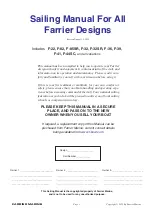
5-5
Section 5 • Care & Maintenance
R
370 Outrage
Preventative maintenance is essential to life of the
metals on your boat. The presence of salt particles
and moisture is the major cause of white spots, pitting
and corrosion.
The use of harsh chemicals can also cause deterioration.
Manufacturers and applicators of protective coatings
will not warrant protective coatings on metals in the
marine environment. Proper owner maintenance is
required to reduce deterioration which will result in
most cases by failure to wash down and wipe dry
after each use and/or the use of abrasive, acidic or
other improper cleaners.
Wash completely using a soft cloth and mild
detergent to remove salt particles. Hosing alone will
not dislodge all particles.
DO NOT
allow soap to dry
as it may cause stains on coated surfaces. Make sure
to wash and dry the full circumference of aluminum
parts.
Apply an aluminum protectorant at least twice each
year, more frequently as conditions warrant. Neglect
Aluminum Care
rubbing or wiping should be done in the direction of
the polish lines, NOT across them.
Crevice corrosion, a brownish coloring which occurs
where two pieces of stainless hardware meet is
caused by impurities in water and air. It can be easily
cleaned with a good grade marine polish using a
sponge, cloth or small bristled brush (for nooks and
crannies).
will cause pitting of the surface which cannot be
reversed.
Inspect and repair or replace all damaged nylon
bushings, washers or other hardware designed to
prevent contact with dissimilar metals.
Whenever electrical or electronic changes are made
to the boat, a qualifi ed marine technician should
check aluminum parts for stray currents. Make sure
all electronic equipment is properly grounded with
adequate sized wire.
NOTICE
NEVER use abrasive cleaners, detergents or
soft scrub type cleaners to wash your boats
surfaces.
NEVER use abrasive pads, brushes or sponges
to attempt to remove stubborn stains.
NEVER use strong solvents or detergents which
contain chlorine.
NEVER use silver cleaners.
Your boat has been manufactured with a powder
coating on the Hardtop frame.
While most powder coat fi nishes are tougher and
much more flexible than conventional solvent
based paints, they are about the same hardness as
automotive paint, so they will scratch.
To clean a powder coated surface, gently wash with
a clean, soft cloth and a mild detergent followed by
a clear water rinse.
Even though most powder coatings are highly
resisitant, certain solvents can harm them and should
be avoided.
DO NOT APPLY:
• Nail polish remover
• Paint or lacquer thinner
• Motor oils
• Transmission or brake fl uids
• Parts cleaning fl uids
If any of the above should contact the powder coated
surface, immediately wipe the area with a soft, clean
cloth, and wash as described above.
Powder Coated Surfaces
If it is necessary to apply touch-up paint on areas
of the fi nish that have been scratched or damaged
the powder material supplier should be contacted
for their recommendation of the proper touch-up
material to use.
Powder Coating Touch-Up
Summary of Contents for 370 Outrage
Page 2: ......
Page 20: ...xx 370 Outrage R THIS PAGE INTENTIONALLY LEFT BLANK...
Page 162: ...4 16 370 Outrage Section 4 Electrical System R Battery Diagram Sheet 1 Fig 4 16 1...
Page 164: ...4 18 370 Outrage Section 4 Electrical System R Helm Breaker Panel Sheet 3 Fig 4 18 1...
Page 168: ...4 22 370 Outrage Section 4 Electrical System R Windlass Schematic Sheet 7 Fig 4 22 1...
Page 170: ...4 24 370 Outrage Section 4 Electrical System R DC Distribution Panel Sheet 9 Fig 4 24 1...
Page 172: ...4 26 370 Outrage Section 4 Electrical System R Hardtop Scematic Sheet 11 Fig 4 26 1...
Page 180: ...4 34 370 Outrage Section 4 Electrical System R Bilge Wiring Schematic Sheet 19 Fig 4 34 1...












































